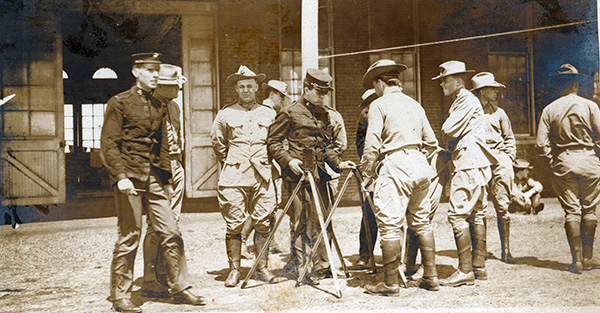The Officer Candidates School
|

Training of Officer Candidates Class of 1909 at Parris Island
|
During the period that Parris Island transitioned from a naval station to a recruit depot, the Marine Corps situated on the island an officer candidates school. Though short-lived, the facility produced some of the Marine Corps’ most prominent leaders.
Since 1903, a school for Marine Corps officers had been located at Annapolis. Then, in 1908, Commandant George F. Elliott made arrangements to transfer the institution to the recently closed naval station on Parris Island. The organizing and equipping of the school was carried out under the command of Marine Capt. Edward Warren Banker, assistant quartermaster who procured the labor and material required to repair the buildings, to place electric lighting systems in working condition, and to purchase furniture for the school.
The facility was opened on Jan. 1, 1909, with Lt. Col. Eli K. Cole commanding. From a pool of 500 candidates, 57 new Marine Corps applicants were selected. The students arrived at Parris Island later that month on board an "ancient" mail boat. The class nicknamed themselves the "famous 57 Varieties" class after the advertising slogan of the H. J. Heinz Company that manufactured 57 products. Upon arrival, they were told that the salt marsh odors were the bodies of applicants who failed to do things the Marine Corps way. The applicants were not impressed with Parris Island. One described the place as being as inviting as the Arctic. They were quartered, three men to a room, in the upper floor of Building 10, a former machine shop that had been converted into a dormitory. Warmth was derived from potbellied coal stoves. All students shaved and bathed within the confines of one lavatory and one shower. A nearby mess hall was operated by a civilian who, for $30 a month from each student provided both food and the services of a cleaning boy who tended to the rooms once each week. Besides the austere conditions, the men had to deal with recurring bouts of dysentery, which required the construction of additional outhouses.
A demanding officer, Cole made an example of the first student who violated the school’s rules. Alexander A. Vandegrift had the dubious distinction of becoming that example, receiving an unmerited general court-martial for returning late from Beaufort. Vandegrift was reduced five promotion numbers, which ensured his being a junior second lieutenant for some years. His fitness report was marked accordingly, and the future commandant was considered unfit "to be entrusted with hazardous and important independent duties."
During the 11 months of training, the students exercised each morning and ran around the station before cleaning their rooms and eating breakfast. Then, they marched to class where they learned about drill, guard instruction, weaponry, tactics, military law, semaphore, engineering, administration, hygiene and naval gunnery. Special classes were also given on courtesies of the service. Despite the isolated condition, the initial class of the "famous 57 varieties" graduated 27 students on Dec. 22, 1909. Among the graduates were Alexander A. Vandegrift, Julian C. Smith, Alfred H. Noble, Roy Stanley Geiger and Alfred A. Cunningham. A second class followed, which graduated on Dec. 20, l9l0.
In conjunction with, but subordinate to, the officers school, an initial effort was made to establish a recruit facility at Parris Island in November 1910. The idea was abandoned when men were needed for an urgent expeditionary force. A second effort ensued on June 1, 1911, on a three-company basis, but few recruits actually trained at Parris Island. Those privates who were in training described the base in similar terms as did the student officers. For instance, one private wrote that the few wooden buildings on the island were "clustered around the slip in front of the Lyceum," and that tents were "scattered around on the sand."
Charles B. Hughes, an instructor in 1911, recalled that those recruits who did not learn as quickly as others were placed in a "coordination platoon." Hughes requested to train these platoons whenever they were formed, since he was convinced there "was no such thing as an inept recruit," and that a good instructor could turn slow learners into good Marines. According to Hughes, it all depended on the instructor, who could "make or break a platoon in the first training day."
The experiment at Parris Island for both the officers school and the recruit depot was temporary. By 1911, both facilities had left the island. The officers school was relocated at the Norfolk Navy Yard while the recruits were temporarily transferred to Charleston, S.C., and then later taken to the Norfolk Navy Yard.